The signing of the Memorandum of Understanding between the Water Research Commission and the Limpopo government, as part of the newly launched Giyani Local Scale Climate Resilience Programme.
CEO says programme to educate local communities about water management systems is on course to reap rewards
The Water Research Commission’s (WRC) CEO Dr Jennifer Molwantwa believes the recent memorandum of understanding signed with the Limpopo government will benefit water-stressed communities if adopted and adequately implemented across municipalities in the province.
The agreement which was signed on 24 July 2023 is part of the Giyani Local Scale Climate Resilience Programme (GLSCRP).
The programme aims to enhance climate resilience and water utilisation in the Giyani area in the north-eastern part of Limpopo. It focuses on scaling and optimising multiple-use water systems, services and alternative energy options.
“We believe as the Water Research Commission that this is a momentous occasion,” Molwantwa said after the signing of the MOU in Polokwane.
The GLSCRP is a three-year community-led programme scaling Multiple Water Use Systems and solar energy to develop, research and demonstrate practical and sustainable water and climate adaptation solutions in Giyani to improve water sources, water utilisation, community resilience and local economic development.
“We have looked at this programme starting at a local level, where we have taken young people, farmers and people who have got challenges around water, and we have used science, innovation, and technology to say, how can they transition and be empowered?” said Molwantwa.
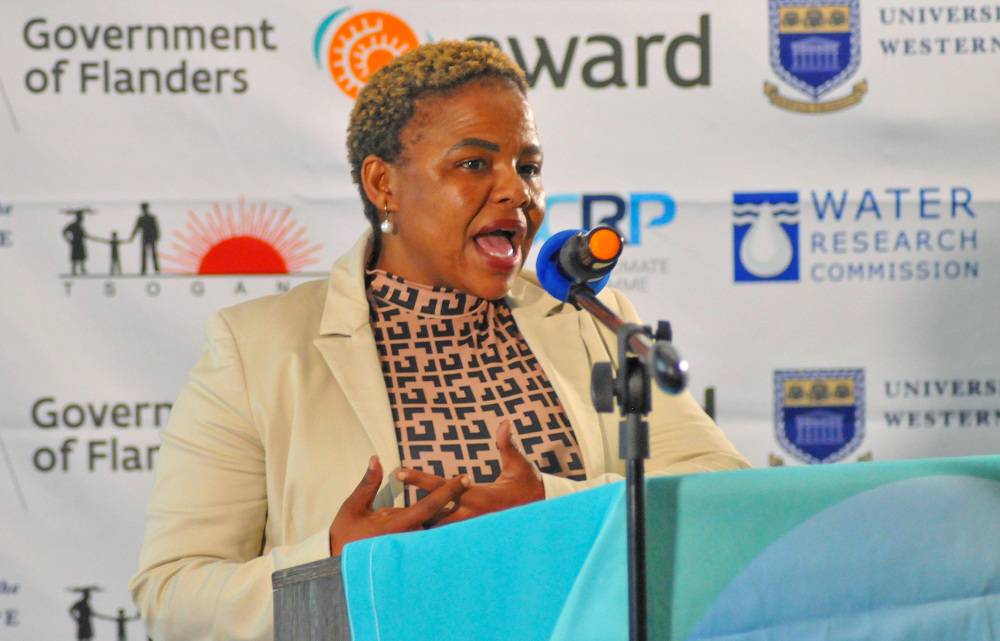 Water Research Commission CEO Dr Jennifer Molwantwa says that science, innovation, and technology is being used to empower communities in Limpopo.
Water Research Commission CEO Dr Jennifer Molwantwa says that science, innovation, and technology is being used to empower communities in Limpopo.
The programme is funded by the Government of Flanders and the WRC, with partners with Tsogang Water and Sanitation, the Association for Water and Rural Development and the University of the Western Cape.
It is currently implemented in five agricultural sites: Daniel Ravalela Farm, Dzumeri Farm, Loloka Farm, Dzumeri Farm 2 and the Muyexe Community Project, and on four community sites: Mbhedle, Mayephu, Mzilela and Matsotsosela, which have a population of approximately 5 000 residents.
“We have given them different tools such as planting out of a bag, which means that when there is when there is limited water availability the small-scale farmers can still plant using less water and not requiring vast pieces of land, because planting happens in a bag; this ensures that the farmer’s livelihood is not impacted negatively,” said the CEO.
“We have also done multiple use of water training and said, when you have water, for example, after you wash, you can use it to water your garden, and be able to grow plants,” she said.
“We have taught the people how to disinfect the water, taking into consideration the fact that there are challenges of water availability — even if there were to be floods, what are people supposed to do when there’s lots of water?
“So we have empowered them in a number of ways, and what is so beautiful is that the people themselves were not forced. They were invited, they were surveyed, but they have shown commitment over the last two years. This is a three-year project that says they are going to be part and parcel. And what we think is so critical is the involvement of the province.”
Molwantwa explained that the selection of Giyani as the initial location of the project came about because the Government of Flanders was already working in the area when the WRC came on board.
“They wanted to continue the work that they used to do in Giyani. It is also very significant because of the … lack of water in that area. The other thing is the fact that with climate change, we know that areas that don’t have water are going to be even more impacted,” she explained.
“It could have been done anywhere else, but when you test your models, you check where there is going to be the highest impact. This is one of the areas in the province that is very hot, and one of the key impacts of climate change is that when it’s so hot, because of evaporation the water in the dams will dry out. So this is a very significant example,” she said.
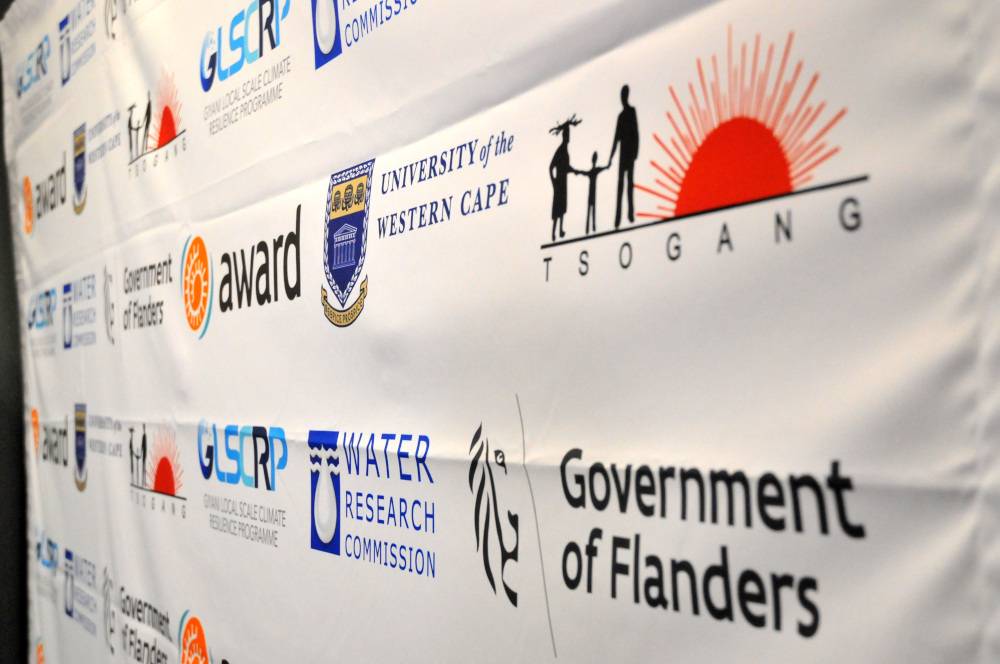 The Government of Flanders is funding the three-year community-led water programme in Giyani.
The Government of Flanders is funding the three-year community-led water programme in Giyani.
Molwantwa believes that the success of the project in Giyani can be replicated in other areas to yield similar positive results.
“It means that from this lesson and case study, this can be taken into other district municipalities as well as other local municipalities. We practise what we call ‘train the trainer’. Now that we have trained the people, they need to start being ambassadors.”
Molwantwa added that it is vital to use science and technology in water preservation, especially in a time of energy crisis.
The Food and Agriculture Organisation of the United Nations (FAO) warns that feeding a global population expected to reach nine billion people by 2050 will require a 60% increase in food production. FAO also cites population growth, rapid urbanisation, changing diets and economic development among some of the factors driving increased demand for water, energy and food.
According to the organisation, agriculture is the largest consumer of the world’s freshwater resources, and more than a quarter of the energy used globally is expended on food production and supply.
“Let’s talk about what we call the water-food-energy nexus. Most of the people who farm worry about water, but they don’t worry about energy. And most of the people who produce energy or use energy don’t care about how energy is involved in the production of water or food,” Molwantwa explained.
“Irrigation by its nature is mechanised, even if it’s drip irrigation or whatever, the most conservative, it’s mechanised. But currently South Africa has a challenge of energy availability, so what are the options that are available? We have used solar as an alternative so that farmers can irrigate without having to worry about the challenges of load-shedding,” she said.
“So what this also tells us is that we need to be planning for climate change impacts. We must not worry too much and say, oh, the people don’t have electricity and therefore there’s nothing we can do. What are the options? What are the alternatives? This challenge of energy is not going to end.”
Molwantwa added that the preservation of water and taking care of natural resources like rivers is key to saving the precious resource, which is in short supply in South Africa.
“We really have to understand that water is expensive, and South Africans assume it rains and therefore water comes out of the tap,” she said.
“Let us try and start thinking we need to pay for services and support our very own government. A case in point is that each and every household will have satellite television. Most of the people in our country have smartphones, but when it comes to that which is life [water] we believe, ‘no, somebody [else] must pay for it’. So we really have to start thinking about conserving water. If you see a leak in the road, make it your business to report it,” she said.
“There’s a lot of wastage in the system. So as a nation, as a people, we [must] understand that water is not limitless. It is a limited resource. And one day when there isn’t water, we are going to have a problem. I always say that we don’t have a problem of water availability, we have a problem of water quality, where if the water is not fit for purpose, then what are you going to do?” — Lucas Ledwaba, Mukurukuru Media
Water for Limpopo, with love from Flanders
The Government of Flanders has invested R40 million into a three-year programme that is already bearing fruit in the drought-stricken Giyani area of Limpopo province.
The agreement is part of the Giyani Local Scale Climate Resilience Programme (GLSCRP), which aims to enhance climate resilience and water utilisation in the Giyani area. The programme focuses on scaling and optimising multiple-use water systems, services and alternative energy options.
 Government of Flanders Deputy-General Representative Nikolas Bosscher says the Giyani Local Scale Climate Resilience Programme will empower communities, promote and develop sustainable agriculture, improve water solutions and foster economic development. Photo: Lucas Ledwaba/Mukurukuru Media
Government of Flanders Deputy-General Representative Nikolas Bosscher says the Giyani Local Scale Climate Resilience Programme will empower communities, promote and develop sustainable agriculture, improve water solutions and foster economic development. Photo: Lucas Ledwaba/Mukurukuru Media
The three-year community-led programme is scaling Multiple Water Use Systems and solar energy to develop, research and demonstrate practical and sustainable water and climate adaptation solutions in Giyani.
Government of Flanders Deputy-General Representative Nikolas Bosscher said the programme is a realistic and much-needed initiative that seeks to solve water challenges in drought-stricken communities.
“The challenges faced by South Africa, particularly in Limpopo, are the semi-arid climate and water delivery or availability issues. In Giyani, these challenges are even more pronounced, especially in meeting the Millenium Development Goals 2026 targets,” Bosscher said at the historic signing of the memorandum of understanding between the Water Research Council (WRC) and the Limpopo Office of the Premier.
The United Nations notes that “between 1990 and 2015, 2.6 billion people gained access to improved drinking water sources” and that “worldwide, 2.1 billion people have gained access to improved sanitation”.
But the agency warns that “despite progress, 2.4 billion are still using unimproved sanitation facilities, including 946 million people who are still practising open defecation”
Bosscher explained how the programme went through project cycle management, where it not only looked at the aims but also consultations done with stakeholders and the beneficiaries.
He said at this stage the programme shows capability to empower communities, promote and develop sustainable agriculture, improve water solutions and foster economic development.
Bosscher said all the communities where this initiative is operating demonstrated notable improvement with respect to implementation capacity, activities, coordination and cooperation.
“We see the positive effects of the programme in water-scarce regions like Giyani, where the programme responds to the needs of the communities. We recognise that every stakeholder, including community leaders, was consulted, which made sense. It gained the support of the programme’s actual users, who are local residents and stakeholders from the municipality and province,” he said.
Bosscher said during his visit to Giyani he got to see how the programme is working out in the nine sites.
“This is a programme that is needed … because it’s a very dry area where water is very scarce, and people need the water for consumption and for sanitation. We also see how well coordinated the programme is, because for the Flanders Government, it’s important to see that the programme has strong buy-in from province, district and local leaders,” he said.
Bosscher said they are impressed with how this initiative makes maximum use of the assistance given by his government, and encourages the WRC to continue to manage the programme successfully.
“We recommend that organisations adopt similar programmes, because they are necessary and pave the way to creating a solution to [conserving] one of the most important things to have, which is water. We believe in the programme and are confident that it will continue even after the funding expires [at the] end of 2024 … thank you for the wonderful work so far,” Bosscher said.
The programme is expected to sustain itself when the funding cycle by the Government of Flanders ends.
Tendani Masindi, Chief Director in the Limpopo Office of the Premier responsible for integrated planning, infrastructure planning and project management, said the partnership with the Flanders government came about as a result of their work with the WRC.
“Through the Water Research Commission, we were able to benefit from their funding model. That is how we find ourselves with Flanders today and we really welcome this initiative,” said Masindi.
The Limpopo provincial government has invited the public to witness the positive impact of the GLSCRP firsthand, and encourages people to visit the areas in Greater Giyani Municipality to see the implementation of flushing toilets without reticulated water, showcasing the innovative solutions being developed to address the water challenges faced by the communities there.
Limpopo’s Deputy Director General for Stakeholder Management Coordination, Walter Segooa — who signed the memorandum on behalf of the provincial government — emphasised the alignment of the strategic partnership with the key priorities and aspirations of the Limpopo Development Plan (LDP).
The LDP aims to ensure integrated and sustainable socioeconomic and infrastructure development while improving the quality of life for Limpopo citizens. The South African government and Flanders have a longstanding cooperation, with the National Treasury of South Africa as the strategic partner for development cooperation.
The working together grew from other smaller projects and multiple partners to a more focused approach, resulting in one-year programmes, which were replaced by five-year Country Strategy Papers (CSPs).
The CSP 2012-2016 took a different approach and focused mainly on job creation through the development of SMMEs and social enterprises. Government, civil society, international organisations and the private sector were involved in the implementation. In March Flemish Minister for Finance, Budget, Housing and Immovable Heritage Matthias Diependaele visited South Africa for the signing of six new agreements between Flanders and South African academic institutions, to strengthen their existing partnerships.
Earlier this year president Cyril Ramaphosa hosted Prince Philippe and Queen Mathilda of the Kingdom of Belgium during a visit that was described as “ a demonstration of the strong bilateral relations that exist between the two countries”. Flanders is one of three federated regions of Belgium. — Lerato Seerane, Mukurukuru Media
Partnership to ensure taps never dry in Giyani
The Water Research Commission (WRC) and the Limpopo Office of the Premier are on a mission to ensure that the taps in Giyani never run dry by using scientific innovation and indigenous knowledge systems to improve water supply.
Dr Jennifer Molwantwa, CEO of the WRC, emphasised the importance of harnessing skills and knowledge to empower communities to manage their own environment.
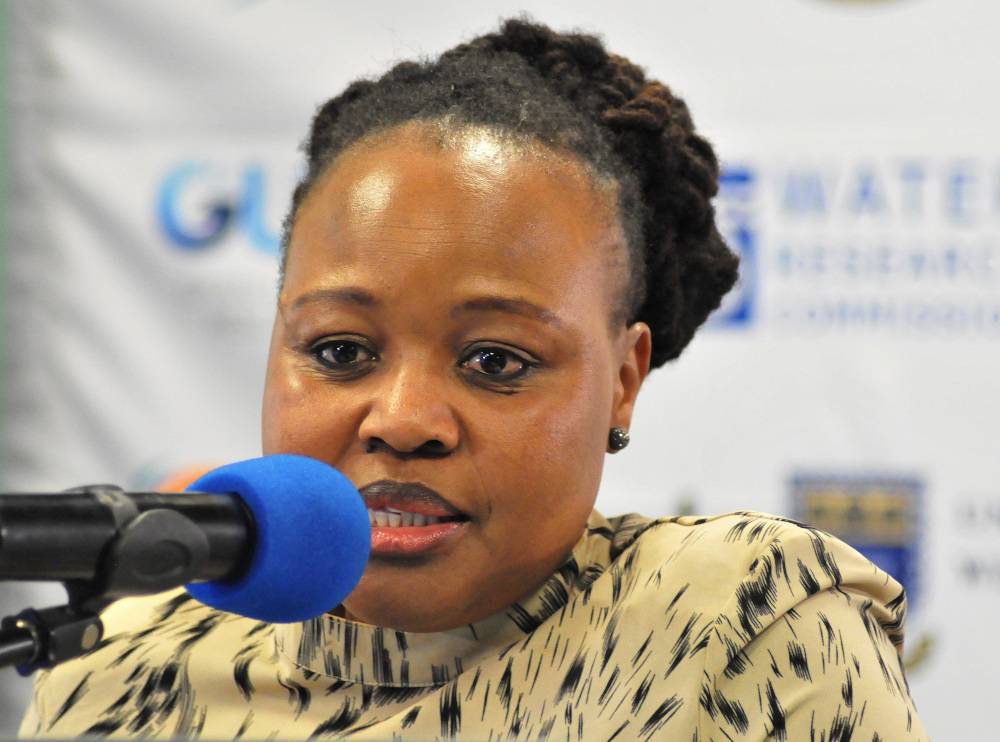 WRC Programme Manager Virginia Molose says there is already improved water and energy infrastructure, just one year into the programme. Photo: Lucas Ledwaba/Mukurukuru Media
WRC Programme Manager Virginia Molose says there is already improved water and energy infrastructure, just one year into the programme. Photo: Lucas Ledwaba/Mukurukuru Media
“This project has laid the foundation for us to learn and do more with less. The lessons learned from this programme will serve as valuable information and knowledge for future endeavours. Indigenous knowledge, combined with scientific innovation, has been instrumental in helping communities adapt and progress,” she said.
Walter Segooa, Deputy Director General for Stakeholder Management Coordination — who signed a memorandum of understanding with the WRC on behalf of the provincial government — has emphasised the alignment of this strategic partnership with the key priorities and aspirations of the Limpopo Development Plan (LDP).
The LDP aims to ensure integrated and sustainable socioeconomic and infrastructure development, while improving the quality of life for Limpopo citizens.
“We believe that knowledge resides in communities and we are facilitators that aim to bring out the best in these communities, because when you walk in the streets of Giyani, you can see the empty stalls that actually say that there was some kind of viable economy before. So we want to bring back those activities and boost the economy,” said WRC Programme Manager Virginia Molose.
She said the WRC examined how it could find reliable alternatives for water and electricity supply in ways that are climate smart, consistent and work as a substitute, because the area is dry, with limited resources.
“Our programmes introduced technological models that are now used in these communities, working along with the Mopani District Municipality, because even though they try to do what they can, water supply is inconsistent due to our energy supply, which has become rather unstable,” said Molose. “So with models like solar, when there is load-shedding, guaranteed sunlight kicks in to give energy that helps the operations to run successfully.”
She said that just over a year into the programme, there is already improved water and energy infrastructure. The areas concerned receive a lot of sunlight so solar systems have been installed, which are reliable, cost less and ensure sustainable water services.
The Food and Agriculture Organisation of the United Nations (FAO) notes in a report on water management that “solar irrigation is an increasingly reliable, relatively low-cost, clean-energy solution for agricultural water management in areas with high incident solar radiation”.
The organisation further notes that “in many rural areas, solar irrigation initiatives can be a way of providing broader access to energy for agriculture, as well as for other uses in rural areas where reliable access to electricity is lacking or diesel is expensive.”
She said the WRC researches the entire water chain, which involves sanitation, and matches it with climate-smart technologies which, even in their simplest form, will see farmers increasing their production.
“The other sustainable climate-smart form which operates similarly to the greenhouse effect, but in the form of little pockets that link together, is a plant-in-a-bag method that helps farmers maintain a good percentage of produce using less space,” she said.
“Also, communities are beginning to come together in the implementation of this programme by utilising an app that estimates for them how much water they use and what crops are better suited to that environment, allowing us to be climate aware without reducing farmers’ yields,” Molose said.
In response to climate change challenges a feasibility study was conducted in 2019/2020 in the drought-stricken regions of Giyani. The study sampled about 45 areas. Nine areas from Mopani district and Greater Giyani Local municipality were identified by the research as the worst affected.
Molose said infrastructure has been improved and work has been done to support the mandate of the Greater Giyani Local Municipality and Mopani District Municipality.
“This is to make sure that taps never run dry in those areas,” said Molose, adding that more focus has been put on helping local farmers and small businesses, to improve the local economy.
The Giyani Local Scale Climate Resilience Programme (GLSCRP) is an ambitious initiative under the WRC aimed at addressing the adverse impacts of climate change in the Giyani region.
The GLSCRP focuses on both drinking water and water for production purposes. The programme aims to make water challenges a thing of the past in Giyani, and it also upskills the residents of these drought-stricken areas.
The work entails technology-driven predictive models, coupled with satellite data and climate monitoring, and provides support through training and capacity development, strengthening networks for collaboration, innovation and technology implementation.
Molose explained that some of the reasons that motivated the launch of the programme in Giyani include dwindling water supplies and the fact that communities rely on electricity for their water supply systems, which have been impacted by load-shedding.
Giyani residents who have borne the brunt of chronic water shortages are also set to benefit from a project by the Department of Water and Sanitation.
Minister of Water and Sanitation Senzo Mchunu announced in April that the Giyani Water Project is on course, and that 24 out of 55 villages meant to benefit from the project will soon get water. He announced in April that his department is providing funding and support to the Mopani District Municipality through its Water Services Infrastructure Grant for the reticulation of 55 villages. The Department said this is set to increase the level of services, from communal taps to yard connections, as part of the Giyani Bulk Water Supply Scheme.
“The highlight is to have people learn about climate change and implement solutions, because when there is water we see change in people’s lives, and water remains a crucial component to support those activities,” Molose said.
“We are signing a MoU with the office of the premier recognising that WRC, local municipalities, government and communities cannot do it alone but through collaboration. We want our work to be recognised. We need the Limpopo government to ensure that our work will continue to be sustainable, even after the programme comes to an end.” — Lerato Seerane, Mukurukuru Media
Limpopo residents must not lose hope – water is on its way
The people of Limpopo should not lose hope when it comes to water provision because work is ongoing to ensure that they have access to clean water and sanitation.
A pioneering project aligned to the District Development Model is turning the tide against water shortages.
“As a province, we are not going to leave them [people of Limpopo] behind. My message is that they should not lose hope,” Tendani Masindi, Chief Director in the Limpopo Office of the Premier, said after the recent signing of a memorandum of understanding with the Water Research Commission (WRC).
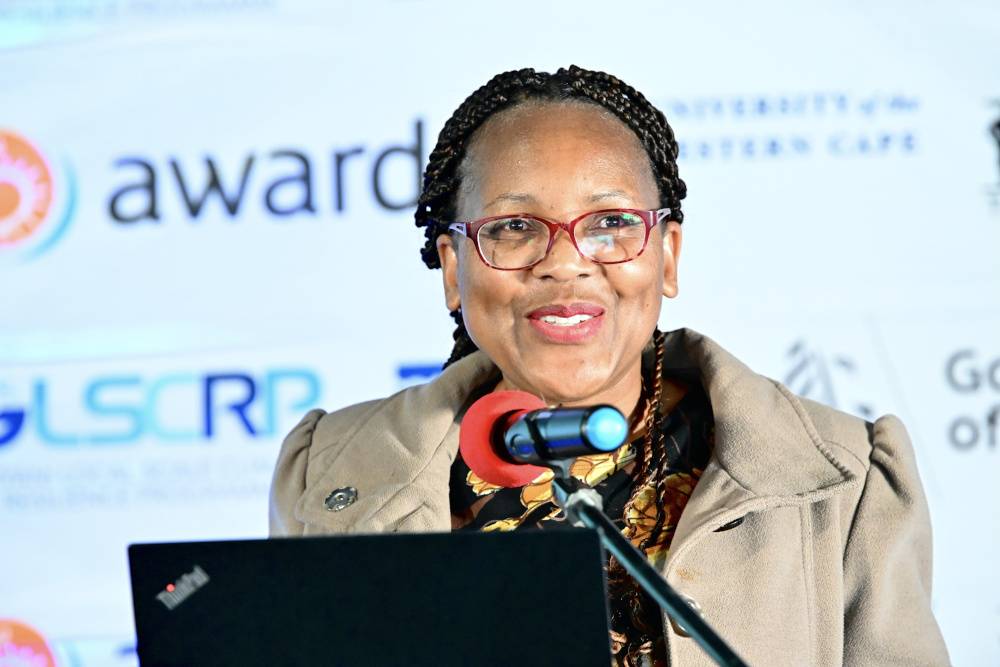 Tendani Masindi, Chief Director in the Limpopo Office of the Premier (above), said the province is committed to providing water for its people.
Tendani Masindi, Chief Director in the Limpopo Office of the Premier (above), said the province is committed to providing water for its people.
Masindi is responsible for integrated planning, infrastructure planning and project management in the premier’s office.
In recent years the Giyani region has experienced significant impacts from climate change, including more frequent and severe droughts, erratic rainfall patterns and increased water scarcity.
The Limpopo Development Plan (LDP) notes that the province has been identified as the most vulnerable in terms of climate change impact. The WRC warned that the changes in weather patterns have adversely affected agriculture, livestock farming, and water availability for domestic use, posing substantial challenges to the livelihoods and wellbeing of local communities.
However, said the WRC, through comprehensive research and data analysis, the Giyani Local Scale Climate Resilience Programme (GLSCRP) aims to deepen the understanding of these climate change impacts and develop evidence-based strategies to mitigate their adverse effects.
“We have committed ourselves to say development is about them [the people]. So, whatever we are doing, we are doing it for them. They should not lose hope. We are still going to enter into additional agreements for their sake,” Masindi said.
 In recent years the Giyani region has experienced significant impacts from climate change, including more frequent and severe droughts, erratic rainfall patterns and increased water scarcity. The GLSCRP is responding to the needs of the local communities in addressing this crisis.
In recent years the Giyani region has experienced significant impacts from climate change, including more frequent and severe droughts, erratic rainfall patterns and increased water scarcity. The GLSCRP is responding to the needs of the local communities in addressing this crisis.
The GLSCRP seeks to address the challenges posed by climate change and ensure a more resilient and prosperous future for local communities through collaborative partnerships, innovative solutions, community engagement and rigorous monitoring.
“This is the programme that will also augment the work that is already happening from the side of municipalities in terms of water provision. We have indicated that by 2025, we are so ambitious and confident as a province that we will be able to reach about 80% [of people] in terms of provision of water,” Masindi said.
“But then given all other challenges that will relate to finance, this [partnership with WRC] support is welcome, so that we are then able to join hands in terms of meeting that target,” Masindi said.
According to the WRC the primary objectives of the GLSCRP are to enhance water utilisation efficiency, improve water access and sanitation, strengthen community resilience, and promote sustainable livelihoods in the Giyani region.
The WRC said that to achieve these objectives, the programme engages with key stakeholders including the Limpopo Office of the Premier, the National Department of Water and Sanitation, the Mopani District Municipality and the Greater Giyani Municipality among others.
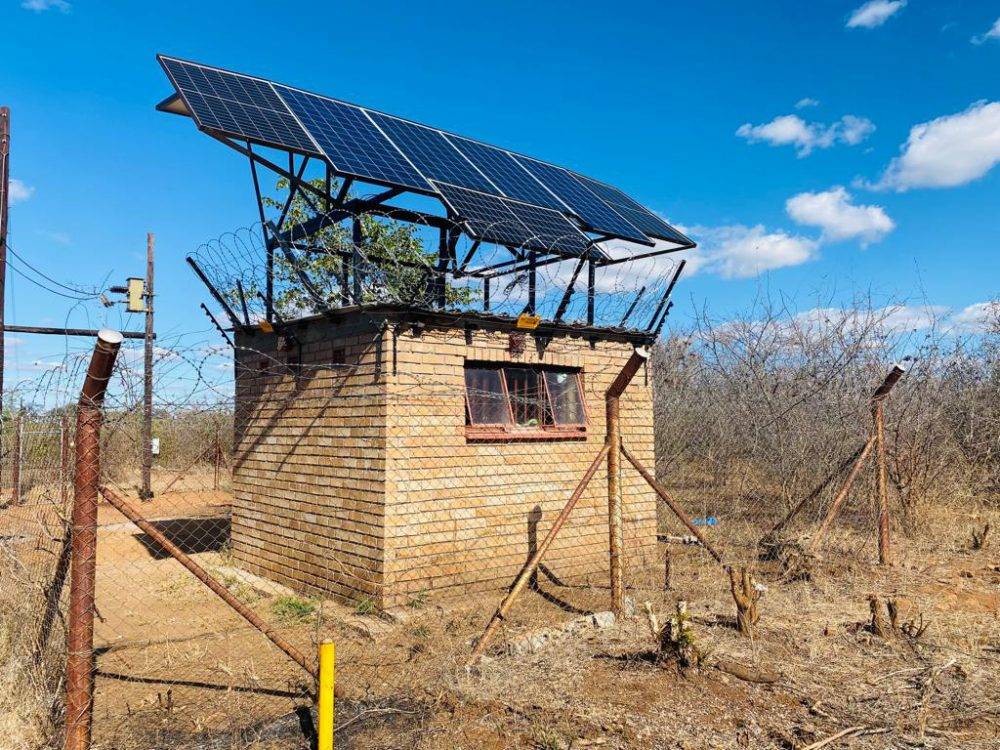 A solar-powered pump house at Ahi Tirheni Mqekwa Agricultural Primary Cooperative.
A solar-powered pump house at Ahi Tirheni Mqekwa Agricultural Primary Cooperative.
It also includes cooperation with the Department of Cooperative Governance, Human Settlements and Traditional Affairs (COGSHTA), the South African Local Government Authority (SALGA), the Limpopo Department of Agriculture and Rural Development (LDARD), the Limpopo Department of Economic Development, Environment, and Tourism (LEDET), local councillors, traditional authorities, community leaders, the agriculture sector, and small businesses, local traders, cooperatives, and subsistence, commercial and smallholder farmers.
Masindi said the collaborative efforts involving different stakeholders is a perfect example of the District Development Model (DDM).
The main objectives of the DDM which was launched by President Cyril Rampahosa in 2019 include focusing on the district or metropolitan spaces as the appropriate scale and arena for intergovernmental planning and coordination.
It also aims to produce a spatially integrated single government plan that guides and directs government-wide strategic investment spending, project delivery and accountability for each district and metropolitan area.
“Moving forward the DDM requires us to join hands in dealing with the challenge of water in the country and in certain areas where we are able to, we should be able to do that. So you can see the DDM at play throughout the implementation of this project. And it gives hope to those who are still waiting for water,” Masindi said.
Masindi added that there needs to be greater emphasis on areas where there is greater potential.
“We are hoping that there will be a trickle-down effect. When communities that do not have water see their neighbours getting water, then they know they are also in line to receive water,”she said.
Earlier this year Limpopo Premier Chupu Mathabatha said in his State of the Province Address that water provisioning is high on the provincial government’s agenda.
Mathabatha said during engagements with Minister of Water and Sanitation Senzo Mchunu, it was agreed that they have to expedite bulk water infrastructure projects, especially the Nandoni-Nsami 33 Bulk pipeline, Giyani Water Treatment Phase 1, Giyani Water Services, and the Loskop Regional Bulk Water Supply.
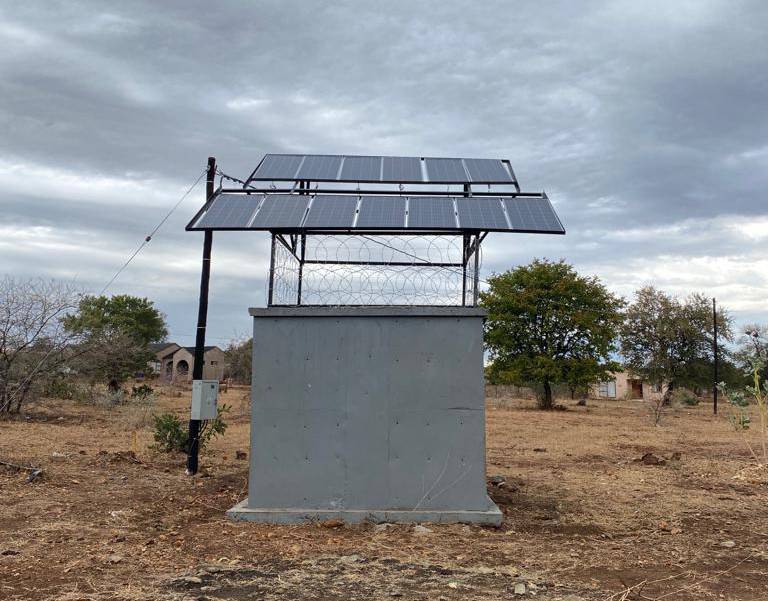 A solar-powered pump house at Mayephu Village.
A solar-powered pump house at Mayephu Village.
“This we must do without hesitation because the people of Giyani have been waiting for water for a long-time. They must drink water before the end of the financial year,” Mathabatha said.
Masindi said one of the key areas being promoted through the GLSCRP is agriculture.
“We are actually promoting agriculture. We are promoting mining and we are promoting tourism. And the area that we are talking about, the Giyani area, the soil type [there] favours agriculture, meaning that with this support our communities will then be able to participate in agricultural activities,” said Masindi.
The WRC is not only working to help make the taps run but is also contributing to scientific research to help come up with innovative technological solutions to water provision by working with universities.
“We are contributing a lot. Even last year we recorded in our annual report 198 PhDs and 48 doctoral fellows who are contributing in terms of capacity,” WRC CEO Jennifer Molwantwa said.
She said the WRC has also collaborated with the University of KwaZulu-Natal and the Melinda Gates Foundation, among others.
“What we have also noticed is that not all science and elevation comes out of the laboratory. Indigenous knowledge is also science that we can tap into. With our new strategy we have said we want to ensure the centres of excellence in each and every province.
“When we are in Limpopo we must be able to work together with the University of Limpopo and the University of the Western Cape (UWC), to ensure that they can learn from each other, and train each other. Once UWC goes home, Limpopo must continue. Students from Limpopo must be able to solve Limpopo problems, and until we get into that mode, we will keep on competing.
“Yes, you must compete, you know, who has IP, who has higher publication rates, but the solutions of the South African people lies with the brains and the knowledge that is generated in South Africa,” she said.
— Lucas Ledwaba, Mukurukuru Media